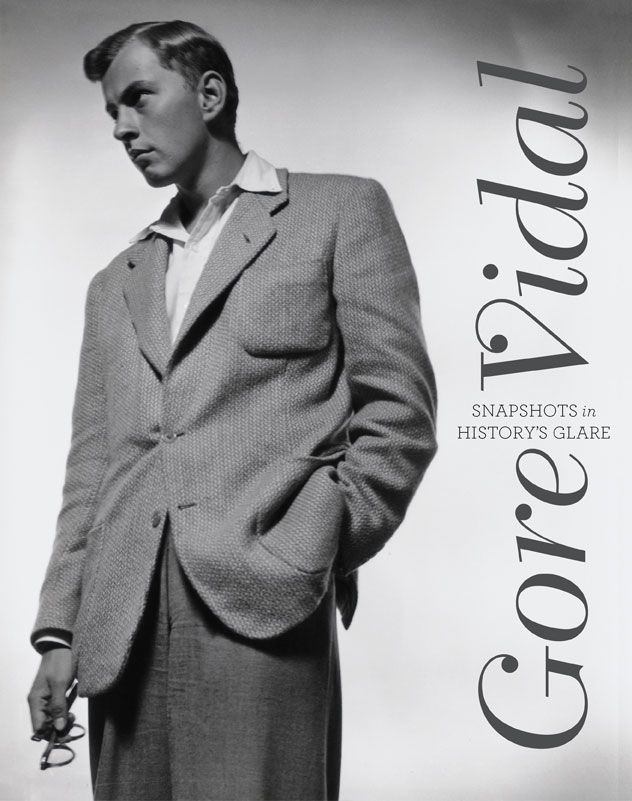Since creating The Gore Vidal Index, I've received many e-mails from people around the world interested in the work of Gore Vidal. Many of these correspondents have asked for more information on Vidal's life and work.
So to help Vidalophiles around the world, I've put together this page of Frequently Asked Questions. If you can't find your Vidal answers here, feel free to send me an e-mail and I'll do the best I can to muster my resources and give you an answer. You can reach me at kloman@pitt.edu.
But please note: The answers I offer here are gleaned entirely from my research and from some limited special resources at my disposal. I have no personal or professional contact with Vidal, and I cannot pose questions to him directly. My pages exist merely as a tribute to his work and as a resource to others interested in his work.
Harry Kloman
University of Pittsburgh
Q: How can I get in touch with Gore Vidal?
A: Vidal's most recent book, a memoir, was published by Doubleday, so you
can always try sending him a letter there:
Gore Vidal
c/o Doubleday
1540 Broadway
New York, NY 10036
Publishing firms are accustomed to getting letters addressed to their authors and will most likely forward them, although it may take a month or so for the letter to get to the author. I understand from people who have written to Mr. Vidal that he writes back, if only briefly because of the volume of mail he no doubt receives.
Q: Does Vidal have an e-mail address?
A: Nope, not as far as I know. But if he did - and if I knew it - I
wouldn't disseminate it. E-mail is a great way to communicate, but it can
also be a great intrusion upon the solitide and privacy of people whom you
don't know personally or with whom you have no professional relationship.
Q: How can I get Vidal to autograph copies of his books that I
own?
A: That's a tough one. You could attempt to send a copy to Doubleday and
then have Doubleday forward it to Vidal at his home in Los Angeles. But I
doubt
a top New York publisher would do something like that. Vidal used to live
in a small town in Italy where everyone knew him.
 But now he lives in Los Angeles, so you couldn't really send a book
to "Gore Vidal, Los Angeles," and hope to have it find him. In short, as
with many famous authors, it's difficult to get a book autographed unless
you're lucky enough to live in a city where he makes a public appearance.
Vidal makes fewer and fewer of those lately, and usually only in cities
like New York, San Francisco, Los Angeles and Washington, D.C.
But now he lives in Los Angeles, so you couldn't really send a book
to "Gore Vidal, Los Angeles," and hope to have it find him. In short, as
with many famous authors, it's difficult to get a book autographed unless
you're lucky enough to live in a city where he makes a public appearance.
Vidal makes fewer and fewer of those lately, and usually only in cities
like New York, San Francisco, Los Angeles and Washington, D.C.
 Q: What will Vidal write or publish next?
Q: What will Vidal write or publish next?
Probably nothing. Word is that Vidal has now retired from writing,
although we'll probably see the occasional essay on Truthdig or other
online sites, as well as fresh interviews from time to time. A publisher
has announced a March
2011 reissue of his three Edgar Box mystery novels: Death in the
Fifth Position, Death Before Bedtime and Death Likes It Hot.
In October 2009, Vidal published Snapshots in History's Glare, an "illustrated memoir" filled with photographs from his archives, many of them never before seen. Ann Schneider, a photo editor at Vanity Fair magazine, collaborated with Vidal in selecting and arranging the photos for the book.
A September 2007 newspaper article reported that Vidal was completing an unfinished play by his friend Tennessee Williams, who died almost a quarter of a century ago. It now looks like this won't come to fruition. Peter Bogdanovich was supposed to direct the play in its Broadway debut. Called "In Masks Outrageous and Austere," it was about cutthroat corporate society.
Finally, Kevin Spacey led the ensemble cast of the movie Shrink, released in 2009, in which he played a drug-addicted psychiatrist to the stars. Gore Vidal was one of his celebrity patients in a cameo role.
Q: Will Vidal be making any public appearances in
the near future?
A: None that I know of. As with his writing, Vidal is largely retired from
public life.
Q: Are Gore Vidal and Vice President Albert Gore Jr. related?
A: Depends upon whom you ask. Vidal says his grandfather, Sen. Thomas P.
Gore of Oklahoma, and Al Gore's father, Sen. Albert Gore Sr. of Tennessee,
were sixth cousins. That would make Gore Vidal and Al Gore Jr. seventh
cousins, once removed. But a professional genealogist who has charted Vice
President Gore's family tree in great detail finds no traceable link
between the two Gore families. You can see this genealogy
here and decide for yourself who's right (scroll down to the
very bottom to page to see what he has to say about Gore Vidal). As it
turn sout, it seems more likely that he's fifth cousins with President
Jimmy Carter - better than an almost-president anyway.
Q: Where can I find copies of the articles that Vidal and William F.
Buckley Jr. each wrote in separate issues of Esquire after their
live TV feud during the 1968 Democratic National Convention in
Chicago? How about a video copy of the encounter itself?
A: Sorry, but I currently know of no place where you can get videotapes of
these dramatic diatribes. My link on the Vidal/Buckley debates
offers one sound and one video clip, but that's it. Vidal's essay, "A
Distasteful Encounter with William F. Buckley," appeared in the September
1969 issue of the magazine. Buckley's piece, "On Experiencing Gore
Vidal," appeared in August 1969. Vidal has never reprinted his essay
about Buckley in any of his collections, but it appears in the 1970 book
Smiling Through the Apocalypse, an anthology of writing from
Esquire published by the magazine itself. Buckley's piece also
appears in this anthology. In addition, Buckley reprinted his piece in his
own 1970 book, The Governor Listeth.
 Q: Where can I buy a video of Gore Vidal's Gore Vidal, a
program created for the BBC and aired on American television's A&E cable
network a few years ago?
Q: Where can I buy a video of Gore Vidal's Gore Vidal, a
program created for the BBC and aired on American television's A&E cable
network a few years ago?
A: I receive numerous inquires about this, but so far, I have not found
any commercially available copies. If you failed to videotape it when it
aired, you're apparently out of luck until A&E broadcasts it again.
However, Vidal did a program for The History Channel called American
Presidency: Heroes or Villains?, and this program is commercially
available in the VHS video section of Amazon.com. It's a TV adaptation of
some of his essays, most notably those collected in The American
Presidency, a little book in which Vidal reflects on the history of
the institution.
Q: Is Vidal's work taught in universities?
A: Yes, it is. In December 2006, I received word from a Chinese visitor to
the Index that Vidal's work is taught in a Chinese university. One teacher
there, a U.S. citizen, has introduced students in the course
"Civilizations Outside China" to such Vidal essays as "The Twelve Caesars"
and "The Second American Revolution" together with chapters from "The
Twelve Caesars" of Suetonius. His students also read "Lincoln" in the
course "American Literature" and discuss it in reference to other American
novels like Richard Russo's "Empire Falls." From time to time I receive
other notes from teachers who use his work, especially his political
novels, in their classes. His political play The Best Man is also
a frequent guest on syllabi.
Vidal is rather popular in Australia. Over the past 12 years, at the Australian Defence Force Academy in Canberra, Professor Heather Neilson has taught, to undergraduates and post-graduates, Burr, 1876, Julian, Creation and Messiah. She also has shown the film Bob Roberts, in which Vidal appears as an actor, at the start of a course called "Dream and Disillusionment: Twentieth Century American Literature."
The late Professor Kurt Albert Mayer of Vienna University's Department of English and American Studies taught a course on Vidal's novels of American history. His web site includes some of his course material. Professer Mayer died unexpected in August 2002, but his web site remains on line. Yordan Kosturkov, a Bulgarian professor of literature, translates Vidal's work into Bulgarian and also teaches some of his work in a survey course of British and American literature. Every now and then, I get an e-mail from a high school student reading Burr or Lincoln, and a while back I got a note from a high school student reading Kalki (a brave choice for a public school assignment, considering that the heroine is openly bisexual). I suspect other universities may have some Vidal in their curriculum somewhere, and I would be glad to learn of specifics.
Finally, here's a classroom study guide for Vidal's 1955 play Visit to a Small Planet. The guide includes a worksheet you can download.
Q: Where can I find a detailed bibliography of Vidal's work?
A: Robert Stanton published a book-length bibliography
of Vidal in 1978. Of course, it's now outdated by almost three decades,
which is especially significant because, since the 1980s, Vidal has seen
his work translated much more widely in Europe, including in many former
 Communist-bloc countries.
Communist-bloc countries.
Stanton's book is thorough up through 1978. Unfortunately, it's impossible to find on used/rare books sites. I happened across a copy in 1994 (not via the internet) and haven't seen one for sale since. It's a very rare Vidal collectible. (G.K. Hall and Co., 226 pages. ISBN: 0816181098.)
But now there's a new bibliography: Steven Abbott - who has known Vidal since the early 1970s - has updated the canon of research on Vidal with his enormous and definitive bibliography. The book includes many illustrations of Vidal's work and a CD with even more images and documents. Another bibliography, published by S.T. Joshi in 2008, is a good and helpful book, but it's not nearly as detailed as Abbott's invaluable resource.
ęCopyright 2009 by
Harry Kloman
University of Pittsburgh
kloman@pitt.edu